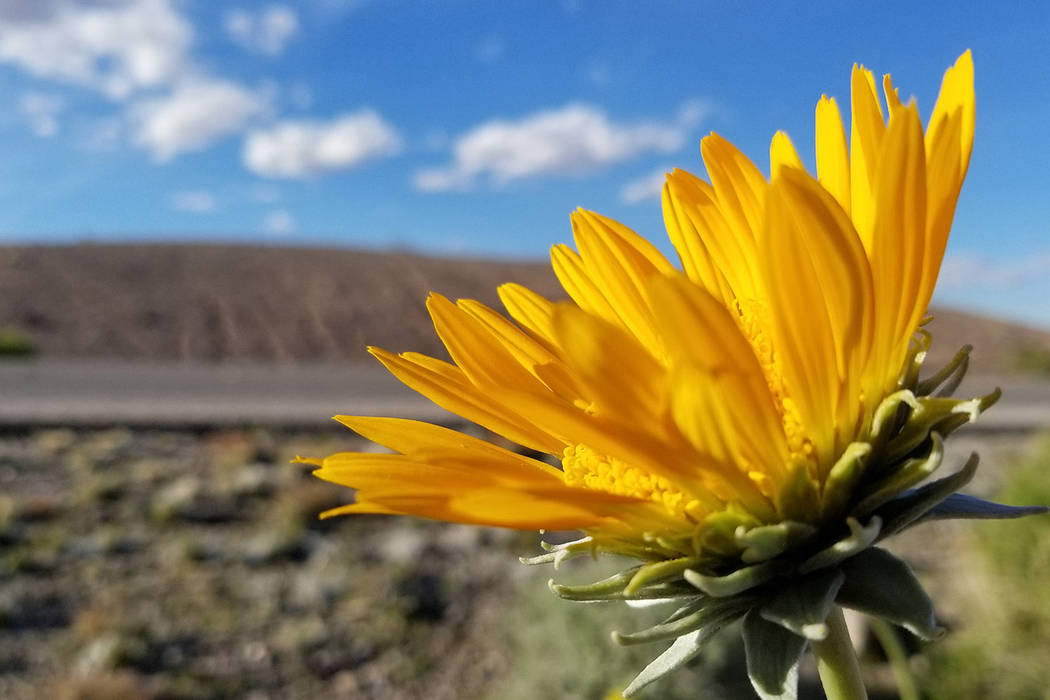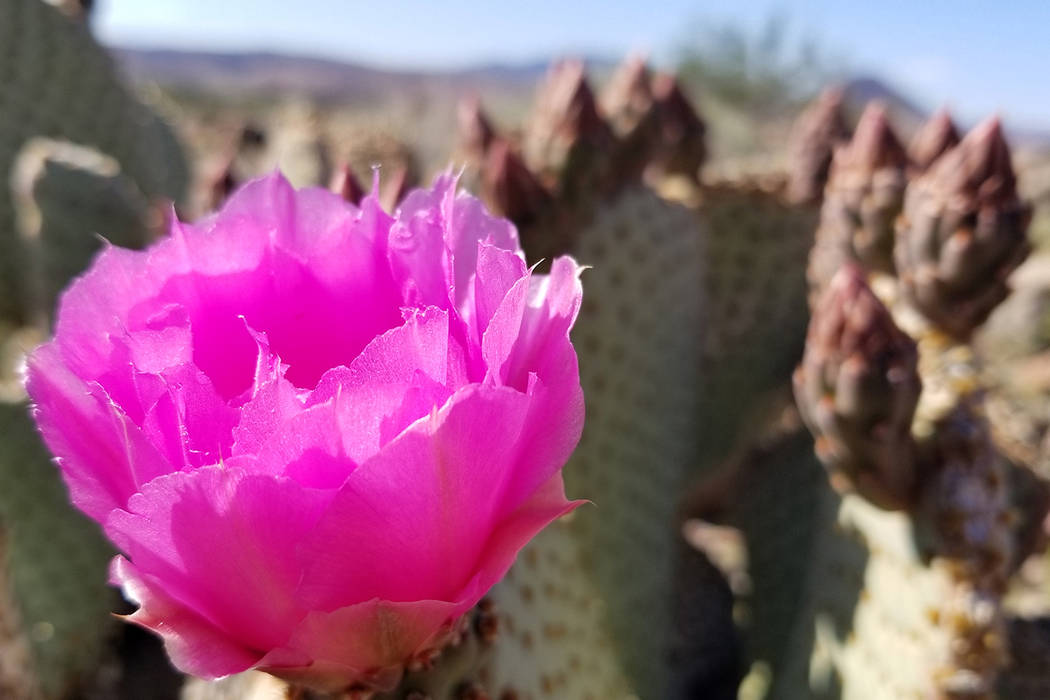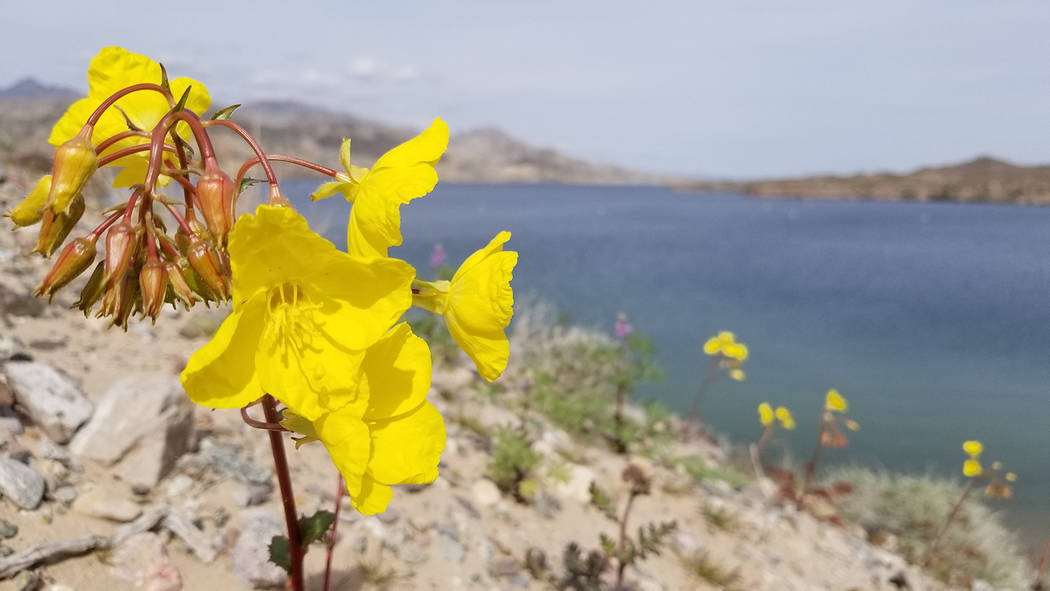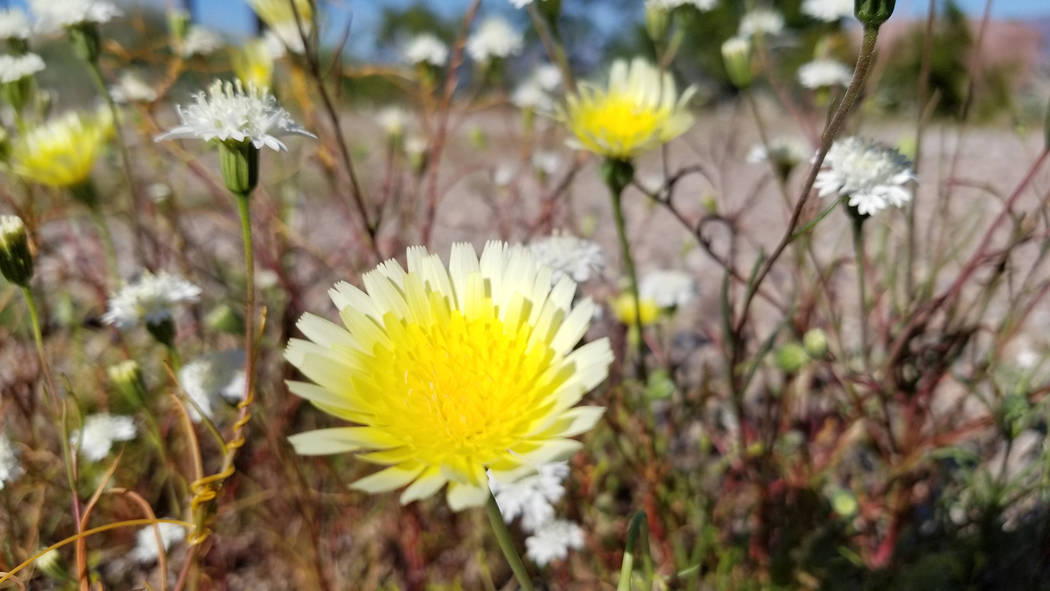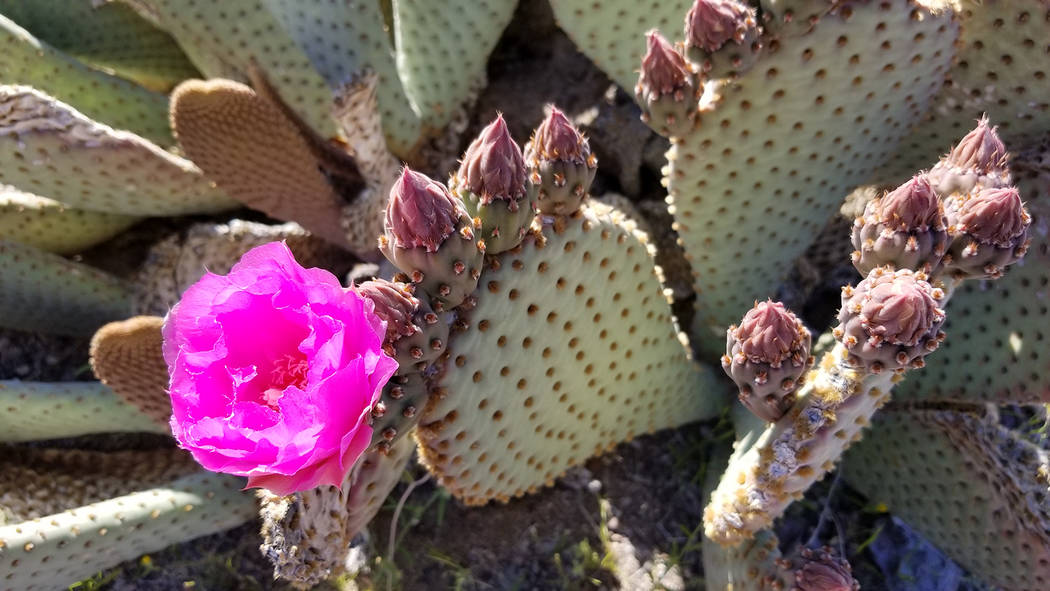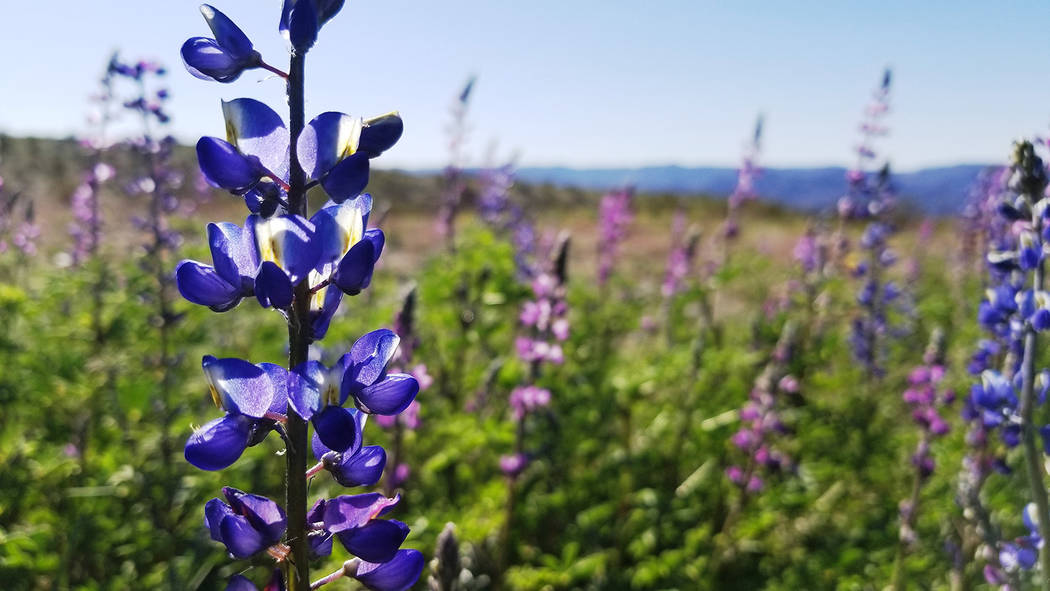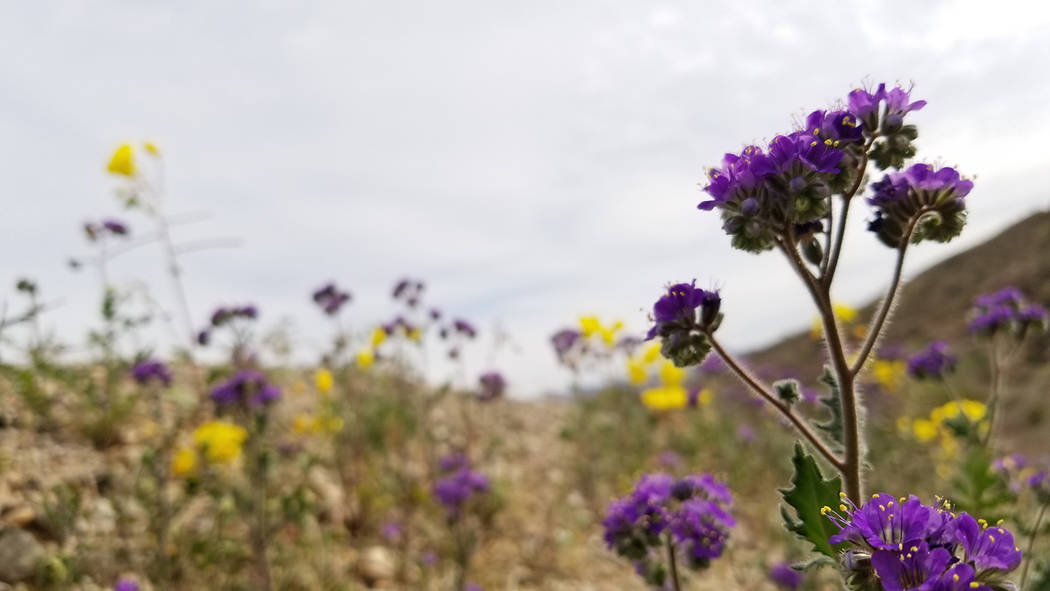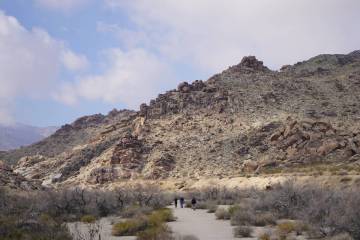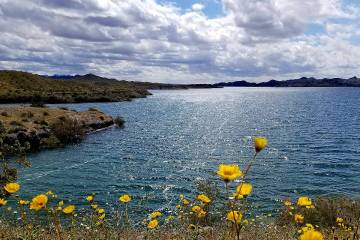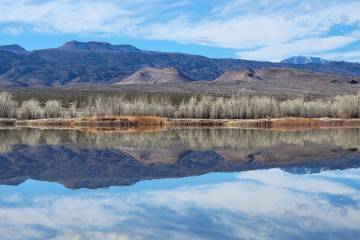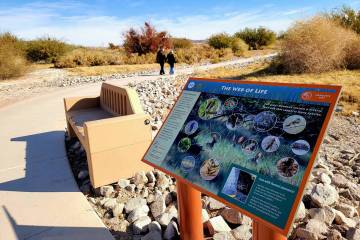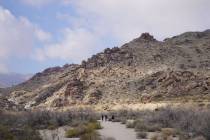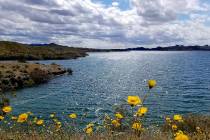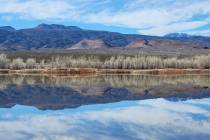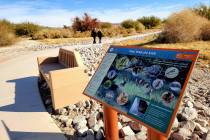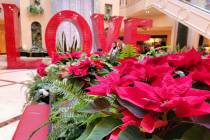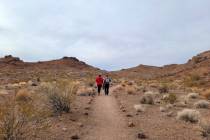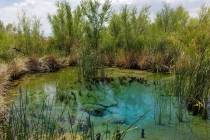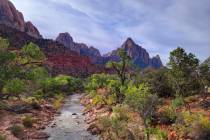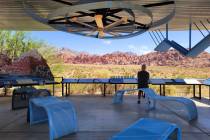Want to see Lake Mead flowers? It’s now or next year
Beavertail, sunray and primrose buds are opening up to greet the sun and present the softer side of our severe, sprawling neighbor to the east. It’s wildflower season at Lake Mead National Recreation Area.
For much of March, a light blanket of what looked like green felt covered hills and rocky fields along Lakeshore Road, where bright yellow brittlebush thrives. Park visitors got to see purple Arizona lupines lining up like soldiers at the entrance station closest to Boulder City and at Willow Beach. Very recently, Lakeshore’s abundant beavertail cactuses started their fuchsia bloom, and they should continue to dazzle for the next couple of weeks. Desert dandelions, Fremont pincushions, evening primrose and desert globemallow took their places last week in a vast bouquet of mostly yellows, some whites and touches of apricot.
Lake Mead vegetation biologist Carrie Norman has been on all the roads and “along every inch of shoreline on the two lakes” of the 1.5 million acres that make up America’s first national recreation area, and she thinks Lake Mead and Lake Mohave’s flowers deserve a bigger fan club.
“I don’t think Lake Mead National Recreation Area gets enough credit for its beautiful flower displays,” she said.
Norman added it’s worth celebrating that so much of the diversity of Lake Mead’s desert bloom is easily accessible.
“The public can just take the paved roads,” she said. “They don’t have to worry about driving into the outback.”
Along those roads, scorpionweed, with its curled “tails” of purple flowers, continues to mix with yellow evening primrose in a Minnesota Vikings color combination. While this plant — officially known as phacelia — can be seen from the comfort of your car, it’s best to get out and do some flower hiking. I’ve walked among phacelia, primrose, monkeyflowers and golden poppies in the washes and on the paths of Majestic and Owl canyons off Lakeshore Road. Earlier in March, the purples and yellows were on display at Willow Beach and at Lake Mohave’s Katherine Landing, far south of Hoover Dam.
Southern Nevada has been a little slow to warm up in 2019, but the heat is on the horizon.
“The impact of cool weather seems to have pushed the blooms a little later than usual,” Norman said. She’s hoping for a bountiful, flowerful April at Lake Mead.
So far, so good. But don’t expect anything close to the super orange bloom of poppies on hills in Southern California.
Instead, if visitors make plans to get out there quickly, they can expect to strike gold with the rare silverleaf sunray while driving a mile or two east of the Lake Mead Parkway fee collection station ($25 for a week or $45 for a year). The striking yellow sunrays are hard to miss, as their reach skyward is about 2 feet off the ground. The challenge is finding a pullout to safely view the flowers. There’s no such thing as safe stopping on the shoulder of this busy two-lane road — just as there’s no substitute for watching exactly where you’re stepping, if you hope to reduce your odds of a close encounter with a rattlesnake.
Wildflower luck has been good for me at picnic areas with lake views found at 33 Hole and Sunset View along Lakeshore, where in March I found the regular yellows and purples as well as small, less-conspicuous flowers usually in whites, pinks and yellows. My copy of Pam MacKay’s “Falcon Guide to Mojave Desert Wildflowers” is never too far away, but that only sometimes translates into me having an easy time identifying unfamiliar blooms. What also helps me add to my flower lists are stops at National Park Service entrance stations, which usually have lots of spring species I’d like to see and a few parking spots.
Northshore Road is one area I neglected as I snooped around for Lake Mead flowers on six occasions during the past month. Blooms there generally happen after those at Lakeshore’s lower elevations, so I plan to return to Lake Mead. Northshore is the path to follow to spot the rare Las Vegas bearpoppy, which grows in gypsum-rich soils and has begun blooming. Two spots to check are near Lake Mead Boulevard’s entrance station and near Rogers Spring toward the north end of the park. I plan to be out there on bearpoppy patrol soon, and I’ll pack a picnic to enjoy at Redstone, a Northshore stop with an easy trail circling gorgeously sculpted sandstone.
Lake Mead’s wildflowers are a stark contrast to their barren-looking habitat, one that’s mostly Mojave Desert but borrows from the Sonoran as well as the Great Basin. The current roadside sprays of yellow are welcome spring sights, as are the medians filled with fuchsia beavertail blooms and the washes offering up a profusion of color and a diversity of species including popcorn flowers, fiddlenecks, suncups and gilia. Bright colors will fade fast, and the landscape will soon revert to its severe summertime look and feel. So get out to Lake Mead while those hardy desert adapters maintain their radiant glow.
Natalie Burt, a former news reporter at the Review-Journal for 11 years, spends as much of her free time as possible enjoying Southern Nevada’s outdoors. She’s now a teacher and has lived in Henderson for 17 years. Email: nvburt@gmail.com.



